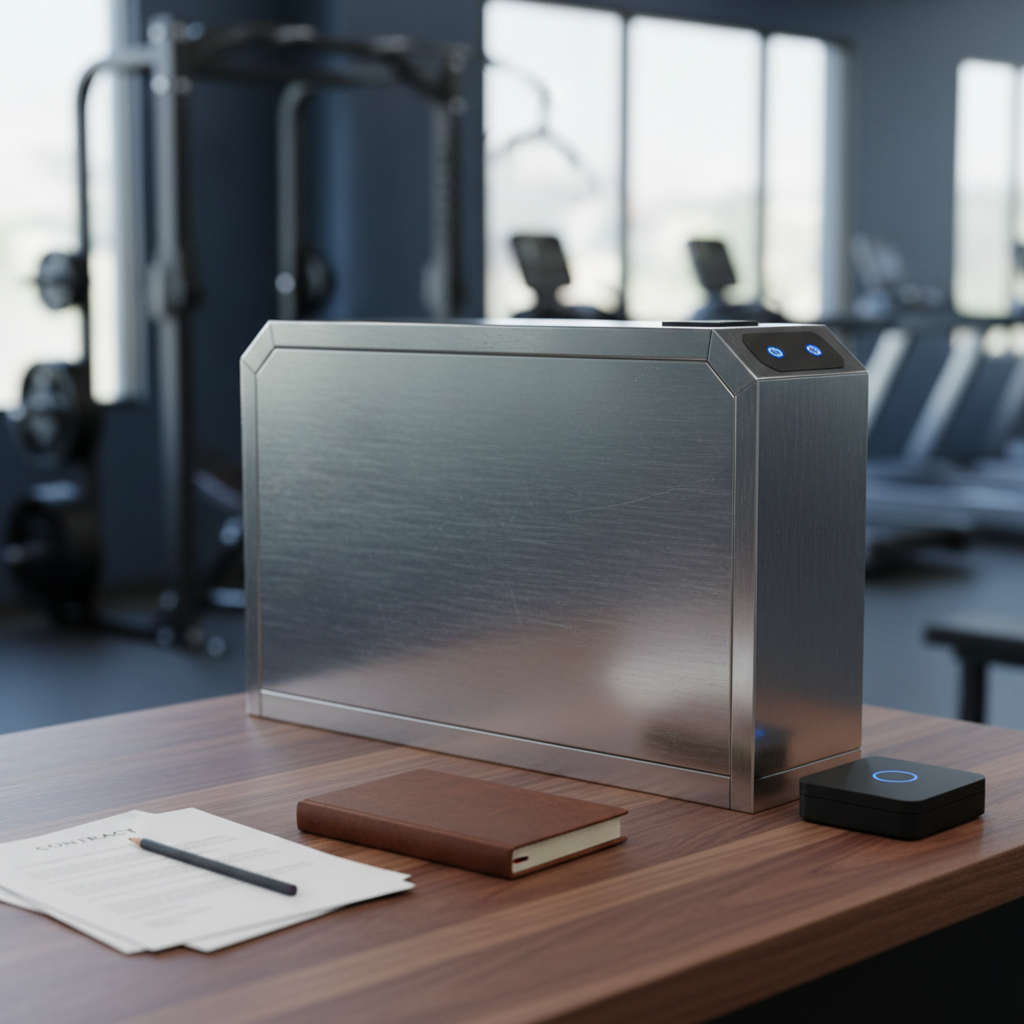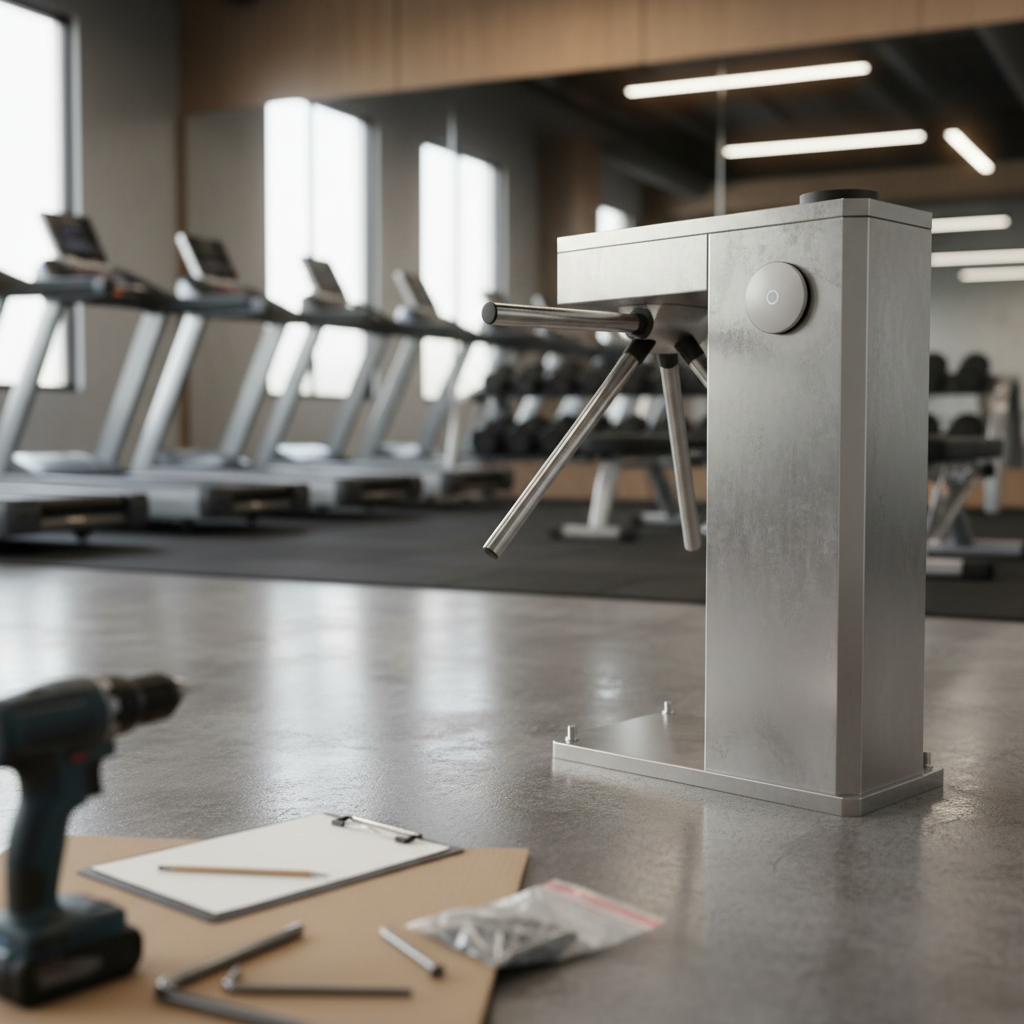How to Calculate Gym Turnstile ROI and Payment Options
When considering turnstiles for your gym, understanding the return on investment and payment methods is crucial for making the right decision. Many gym owners wonder whether investing in physical access barriers makes financial sense compared to relying only on access control systems at the door.
Let's break down the real numbers, payment options, and how to calculate whether turnstiles pay for themselves.
Understanding the Unauthorized Access Problem
The statistics on unauthorized gym access are eye-opening. Research shows that in gyms with only access-controlled doors (without turnstiles) and no reception staff present, approximately 15 out of every 100 people entering fail to scan their access credentials.
When reception is open and staffed, the situation is even worse. About 40 out of 100 people don't scan their credentials when walking past an occupied reception desk.
Not all of these cases represent intentional abuse. Many are simply lazy members who forget to scan. However, the concerning reality is that we have no precise way to know which cases are innocent forgetfulness and which are deliberate unauthorized access.
This uncertainty creates a significant problem for gym owners. Without physical barriers, distinguishing between paying members and non-members becomes nearly impossible.
How Turnstiles Eliminate Unauthorized Access
Turnstiles and gates remove all questionable unauthorized access. This means that if somebody still tries and manages to go through the gate without reading the access credential, it means that he doesn’t have it. It removes all the ambiguity. Nobody “forgets” to scan when the turnstile is adequate.
When you combine turnstiles with AI-powered cameras that detect all unidentified persons, the prevention rate gets very high, Near 99% of unauthorized access attempts are stopped.
The remaining 1% who might still find ways through are now clearly identifiable as violating access rules. You know for certain these individuals don't have valid memberships, allowing you to address the situation however you see fit.
This combination of physical barriers and intelligent monitoring creates accountability that simply doesn't exist with door access control alone.
Calculating the Financial Impact
Let's work through real numbers for a typical gym scenario.
Starting with the 15 unauthorized entries per 100 visits when reception is closed, assume that only 10% of these are actual unauthorized users rather than forgetful members. This conservative estimate gives us 1.5 unauthorized users per 100 visits.
For a gym with 1,000 members, this means approximately 15 people are regularly accessing the facility without paying.
Now we can calculate the financial impact using different approaches.
Approach 1: Contract Violation Fees
In some countries, standard practice includes contract clauses specifying penalties for unauthorized access. These typically range from €80 to €300 per violation.
Let's calculate the first-year recovery using a €150 violation fee:
Initial capture: If you catch all 15 existing unauthorized users immediately, that's 15 × €150 = €2,250 in the first month.
Ongoing monthly captures: Assuming 10% monthly member churn (which is typical for gyms), you'll have new unauthorized users joining regularly. With 10% monthly churn of your 1,000 member base, you get approximately 100 new members monthly, which means 1.5 new potential unauthorized users each month.
First year total: Initial 15 users + (12 months × 1.5 users per month) = 33 unauthorized users caught 33 users × €150 = €4,950 in violation fees collected in year one.
This €4,950 represents direct revenue recovery from addressing unauthorized access through contract enforcement.
Approach 2: Converting to Paying Members
Rather than penalizing unauthorized users, you might convert them to paying members. This approach can generate even more value.
Using a €40 monthly membership fee and factoring in your gym's churn rate, each new paying member represents significant lifetime value.
With typical gym churn rates, a member paying €40 monthly stays an average of 10 months, representing €400 in lifetime value. Let’s assume that only half of the unauthorized users convert to members.
First month value: 7,5 (half of 15) unauthorized users converted × €400 lifetime value = €3,000
Monthly ongoing value: 0,75 new unauthorized users monthly × €400 = €300 per month
First year total: €3,000 + (11 months × €300) = €6,300 in member value generated
This approach generates more revenue than violation fees while also improving your member count and recurring revenue base.
Approach 3: Membership Suspension
A third approach involves freezing the memberships of those caught allowing unauthorized access (such as sharing their access credentials with spouses or friends).
This calculation is more complex because it depends on your specific contract terms and enforcement policies. However, the primary benefit here isn't necessarily immediate financial recovery but rather improved member satisfaction.
When paying members see that everyone accessing the facility is a legitimate member, satisfaction increases significantly. Nobody wants to pay for a service that others access for free.
This satisfaction improvement reduces churn. While we don't have precise statistics on the exact churn reduction percentage, even a small decrease in member turnover has substantial financial impact.
For a 1,000-member gym with €40 monthly fees and 10% monthly churn:
- Current monthly churn cost: 100 members × €40 = €4,000 in lost monthly revenue
- A 10% reduction in churn: 10 fewer cancellations = €400 saved monthly = €4,800 annually
- A 20% reduction in churn: 20 fewer cancellations = €800 saved monthly = €9,600 annually
Even modest churn reduction can significantly impact your bottom line.
Understanding Turnstile Payment Options
Unlike access control software, which is typically subscription-based, turnstiles are physical equipment purchases similar to gym machinery. You have two main payment options:
One-time purchase: Pay the full cost upfront and own the equipment immediately. This is a capital expenditure (CAPEX) that becomes a gym asset.
Leasing: Spread the cost over time with fixed monthly payments. This is an operational expenditure (OPEX) that doesn't require large upfront cash.
Note that turnstiles don't typically offer monthly subscription models like access control software does. You're either buying or leasing physical equipment.
Calculating Turnstile ROI
To determine whether turnstiles make financial sense, compare your monthly costs against your monthly benefits.
Monthly costs include:
- Turnstile leasing payment (if leasing) or depreciated purchase cost
- AI camera system costs (purchase or subscription)
- Minimal maintenance costs
Monthly benefits include:
- Violation fees collected from unauthorized users
- OR converted membership revenue from former unauthorized users
- Reduced churn from improved member satisfaction
- Reduced theft and security incidents
- Accurate occupancy data for fire safety compliance
Let's work through a specific example:
Scenario: 1,000-member gym considering two turnstiles with AI camera system
Monthly costs:
- Turnstile leasing: €200/month (varies by model and lease terms)
- AI camera system subscription: €170/month
- Total monthly cost: €370
Monthly benefits (using member conversion approach):
- 1.5 unauthorized users caught monthly × €400 lifetime value = €600/month in new member value
- Plus estimated 5% churn reduction = €200/month saved
- Total monthly benefit: €800
Net monthly benefit: €800 - €370 = €430 positive cash flow
Annual ROI: €5,160 net benefit on €3,600 annual equipment costs = 143% return
These numbers demonstrate that even with conservative estimates, turnstiles can pay for themselves quickly while providing ongoing positive returns.
Beyond the Financial Returns
While the financial calculation is important, unauthorized access prevention provides additional value that's harder to quantify but equally important for any self-respecting fitness center.
Theft reduction: When only members can enter, theft from lockers and personal belongings decreases significantly. Unauthorized visitors have less accountability and higher incentive to steal.
Theft investigation: When theft does occur, identifying the perpetrator becomes much easier. If only verified members accessed the facility during the theft timeframe, your suspect pool is limited and documented.
Violence prevention: Though rare, gym altercations occasionally occur. Ensuring only members access the facility reduces the risk of incidents involving unauthorized individuals.
Fire safety compliance: Accurate headcounts are essential for fire safety. When unauthorized people access your gym, your occupancy records are wrong. This creates liability issues if an emergency occurs.
Insurance implications: Some insurance policies may offer better rates or coverage when you can demonstrate controlled access with physical barriers.
Professional reputation: Gyms known for letting anyone walk in uninvited develop poor reputations. Members talk, and word spreads about facilities that don't protect member-only access.
These factors don't appear directly in ROI calculations but significantly impact your gym's long-term success and risk profile.
Making the Decision
When evaluating whether to invest in turnstiles, consider both the quantifiable financial returns and the broader operational benefits.
Ask yourself these questions:
How many unauthorized entries do you estimate happen monthly at your gym? Even if you don't have exact numbers, observe your entrance during off-hours to get a sense.
What's your member churn rate, and how much might improved satisfaction reduce it? Even small churn reductions create substantial value.
What's your approach to unauthorized access? Will you charge violation fees, convert users to members, or suspend access privileges?
Can you afford the monthly leasing costs, or do you have capital for upfront purchase? Leasing spreads the cost but increases total paid over time.
What's your risk tolerance for theft, safety issues, and unauthorized access? Some gym owners prioritize security regardless of immediate ROI.
The math typically shows positive returns within 6-12 months for most gyms with 500+ members. Larger facilities see even faster payback periods.
Leasing vs. No Turnstiles
Many gym owners wonder: is leasing turnstiles more economical than simply accepting some level of unauthorized access?
The answer depends on your specific numbers, but for most gyms, leasing is more economical than doing nothing.
Consider that each unauthorized user represents:
- Lost membership revenue (€40/month = €480/year per user)
- Increased facility wear and operating costs
- Reduced paying member satisfaction
- Security and liability risks
With even 15 unauthorized regular users, you're losing €7,200 annually in direct membership revenue alone. This doesn't count the churn cost from dissatisfied paying members or security risks.
Compare this to typical turnstile leasing costs of €200-300 monthly (€2,400-3,600 annually), and the financial case becomes clear. Preventing unauthorized access pays for the turnstile equipment multiple times over.
Implementation Recommendations
If the ROI calculation shows positive returns for your gym, implementation should follow these steps:
Start with accurate baseline data: Monitor your entrance for at least one week to understand current unauthorized access patterns. Document how many people fail to scan credentials.
Choose appropriate technology: Select turnstiles that match your traffic volume and space constraints. Pair them with AI cameras that integrate with your existing access control system.
Communicate with members: Announce the new security measures positively. Frame it as improving fairness and security for paying members, not as punishment.
Establish clear policies: Decide your approach to caught unauthorized users before implementation. Will you charge fees, convert to members, or take other action?
Monitor and adjust: Track results monthly. Are you catching unauthorized users as expected? Is member satisfaction improving? Adjust your approach based on real data.
Calculate actual ROI: After 3-6 months, calculate your actual return on investment using real numbers. This validates your decision and helps plan future security investments.
Conclusion
Turnstiles represent a significant but justified investment for most gyms struggling with unauthorized access. The combination of direct revenue recovery, churn reduction, and operational benefits typically generates positive ROI within the first year.
With leasing options available, even gyms without large capital budgets can implement effective physical access control. The monthly costs are usually offset by the monthly benefits, creating positive cash flow from month one.
Beyond pure financial returns, turnstiles provide peace of mind, professional credibility, and a fair environment for paying members. These intangible benefits often matter as much as the financial returns to gym owners who take pride in running ethical, well-managed facilities.
Calculate your specific numbers using the frameworks provided in this article. Most gym owners find that the math strongly supports investing in proper physical access control, whether through upfront purchase or manageable leasing arrangements.



